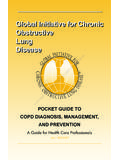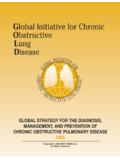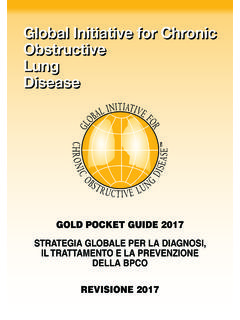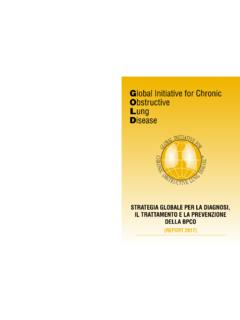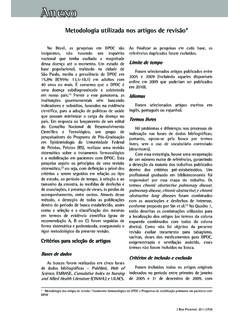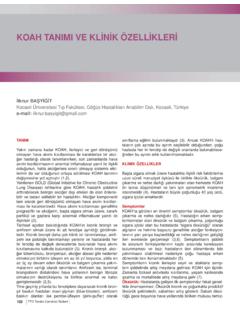Transcription of 9. Summary of observations, discussion, conclusion …
1 9. conclusions and recommendations 9. Summary of observations, discussion , conclusion and recommendations Introduction The 2004 Report Priority Medicines for Europe and the World determined the priority needs for pharmaceutical innovation from a public health perspective and made policy and research recommendations to address these needs. Within this public health context, a key objective throughout the 2004 Report has been the need to identify common areas of interest between Europe and the world as a whole, particularly in the area of discovering and developing new and improved medicines to combat diseases and conditions which pose a current or future threat to public health. This updated 2013 Report has the same objectives. It is important to acknowledge that medicines are of course not the only intervention to prevent, treat and diagnose diseases.
2 In this report, vaccines and diagnostics have therefore also been identified as potential priority areas. The objectives of this report must be set against a backdrop of the key demographic changes that are transforming the global disease burden (Chapter 5). Low- and middle- income countries are currently facing a shift in their disease burden from one that is dominated by communicable diseases towards one dominated by chronic noncommunicable diseases (NCDs). This change has profound implications for health care systems and the development of innovative medicines. These changing disease burdens are entirely predictable. The key drivers are both demographic and epidemiological and include factors such as the ageing population and changes in risk factors such as tobacco and alcohol use as well as obesity which are leading to the increasing prevalence of chronic NCDs.
3 As a result, health systems in many low- and middle-income countries will face a double burden of disease, as NCDs add to the existing burden of communicable diseases and reproductive health problems addressed in the Millennium Development Goals 4, 5 and 6. While the first part of the report, Chapters 1 to 6, identifies high-burden diseases and substantial risk factors for which pharmaceutical gaps exist, Chapter 7 takes a more holistic approach and looks at common themes around children, women, the elderly and the new concept of stratified medicine. Chapter 8 builds on work done in the 2004. Report to identify incentive systems for pharmaceutical innovation in Europe, that increase efficiency and equity and involve patients and citizens in key decisions that affect them. The chapter suggests multiple approaches for addressing identified pharmaceutical gaps, including through proposed incentives for the pharmaceutical industry.
4 1. Priority Medicines for Europe and the World 2013 Update Methods used in the updated 2013 Report The methods used in the updated 2013 Report are similar, but not identical, to those used in the 2004 Priority Medicines Report (see Chapter 4 and the related Background Paper). Several key criteria were used to define a preliminary list of diseases which would be reviewed in depth. To this end the WHO Global Burden of Disease dataset was used to determine the highest disease burdens in Europe and the world, with the explicit inclusion of critical risk factors (tobacco and alcohol use and obesity). In addition, the concept of social solidarity (rare diseases, neglected tropical diseases), and public health projections (pandemic influenza and increasing antimicrobial resistance (AMR)) were used as additional criteria, as in the 2004 Report.
5 However, in contrast to the 2004 Report, the pharmaceutical gaps were not investigated via a Cochrane analysis prior to writing full reviews. Such investigations were included as part of the full in-depth reviews (Chapter ) and are presented in the background papers. Authors of the reviews identified research topics which would be the most beneficial from a public health point of view. Data sources were expanded from the original WHO 2004 Global Burden of Disease dataset to include the WHO projections for both Disability Adjusted Life Years (DALYs). and mortality for 2008 as well as data from the 2010 Global Burden of Disease Study (GBD 2010 Study) as published in The Lancet in December 2012. However, the GBD. 2010 Study used a different methodology and different geographical regions, making it challenging to compare the burden of disease results between the WHO projections and the GBD 2010 Study.
6 All previously reviewed diseases from the 2004 Report were again included in the final list of detailed reviews in the 2013 Report. In addition, some new topics that emerged as relevant in the top 20 diseases in the GBD 2010 study were included. This resulted in the addition of six new diseases and risk factors due to their high disease burden: obesity, diarrhoeal diseases, hearing loss, pneumonia, neonatal conditions and low back pain. Under cross-cutting themes (Chapter 7), a new section is included on stratified medicine because of its potential impact on clinical practice over the next decade. In the chapter on incentive systems for innovation (Chapter 8), new sections have been added on the use of real-world data through the availability of electronic health records (EHR).
7 To support innovation and on the role of patients and citizens in priority setting for pharmaceutical innovation. Priority medicines and pharmaceutical gaps Priority medicines as defined in this report are medicines which are needed to meet the future priority health care needs of the population. They are needed because a treatment gap exists for a number of high-burden diseases and conditions. Different types of treatment gaps include: 2. 9. conclusions and recommendations Gap 1: Treatment(s) exist but will soon become ineffective;. Gap 2: Treatment(s) exist but the pharmaceutical delivery mechanism or formulation is not appropriate for the target population;. Gap 3: Treatment does not exist OR is not sufficiently effective. The three categories are non-exclusive. For example, malaria could be placed in Gap 1.
8 (medicines will become ineffective due to AMR) or Gap 3 (no medicines or vaccine exists) as no malaria vaccine is available. Similarly, HIV might be placed in Gap 2. (treatment is available but there is a need for paediatric formulations) or Gap 1 (the current treatment might become ineffective) or Gap 3 (no vaccine exists). While the focus of this report is on pharmaceuticals needed to fill treatment gaps, the importance of prevention cannot be overemphasized. For many conditions prevention is of paramount importance and remains underutilized for conditions and risk factors such as chronic obstructive pulmonary disease (COPD), liver cirrhosis, type 2 diabetes, tobacco use, alcohol consumption and obesity. A fourth category has therefore been created (Gap 4) to address the problem of key risk factors for disease (obesity, tobacco use, alcohol use).
9 A brief Summary and recommendations are provided below for each of the diseases, conditions and risk factors identified. More information on these conditions can be found in the individual sections of Chapter 6 and in the background papers. Gap 1: Treatment(s) will soon become ineffective Antibacterial resistance Antimicrobial resistance remains a serious threat to global health, with an increase in the spread of new highly-resistant organisms, including many Gram-negative bacteria and those causing tuberculosis (TB) and malaria. Some progress has been made since 2004 with increased funding from the Innovative Medicines Initiative (IMI) for research into AMR. Continued surveillance is needed both in Europe and worldwide as well as close cooperation between countries in order to combat the threat of AMR.
10 There also remains a need for new and rapid diagnostics, for new business and R&D models, and for alternatives to the use of antibacterials, such as substances to modify host/pathogen interactions or vaccination for primary prevention of infection. As stressed by the European Commission and public health authorities, vaccination can and should be play a key complementary role in anti-microbial resistance programmes. Pandemic influenza Since 2004, an influenza pandemic has occurred, stimulating the development and mass production of new types of vaccines. In the current inter-pandemic period, various gaps exist in therapy and access to vaccines. Among these challenges are: the low uptake of inter-pandemic seasonal immunization, which limits production 3. Priority Medicines for Europe and the World 2013 Update capacity and restricts the world's surge capacity in times of a pandemic; rapidly mutating viruses that require new vaccines (including adjuvanted vaccines); and the need for more antiviral compounds.










